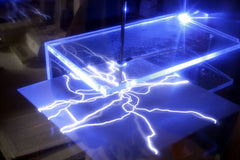Dielectric Strength
Dielectric Breakdown
An electric field causes small displacements of the bound charges in a dielectric material, resulting in polarization.
If the electric field is very strong, it will pull electrons completely out of the molecules. The electrons will accelerate under the influence of the electric field, collide violently with the molecular lattice structure, and cause permanent dislocations and damage in the material.
Avalanche effect of ionization due to collisions may occur. The material will become conducting, and large currents may result.
This phenomenon is called a dielectric breakdown.

Dielectric Strength
The maximum electric field intensity that a dielectric material can withstand without breakdown is the dielectric strength of the material.
Don't confuse the dielectric strength of a material with its dielectric constant.
A convenient number to remember is that the dielectric strength of air at the atmospheric pressure is 3 kV/mm. When the electric field intensity exceeds this value, air breaks down. Massive ionization takes place, and sparking (corona discharge) follows.
Dielectric Strength for Some Materials
Material |
Dielectric Strength(Million Volts/Meter) |
| air | 3 |
| amber | 90 |
| bakelite | 12, 24 |
| diamond, type IIa | 10 |
| glass, pyrex 7740 | 13, 14 |
| mica, muscovite | 160 |
| nylon | 14 |
| oil, silicone | 15 |
| oil, transformer | 12, 27 |
| paper | 14, 16 |
| polyethylene | 50, 500-700, 18 |
| polystyrene | 24, 25, 400-600 |
| polyvinyl chloride (PVC) | 40 |
| porcelain | 4, 12 |
| quartz, fused | 8 |
| rubber, neoprene | 12, 12 |
| strontium titanate | 8 |
| teflon | 60 |
| titanium dioxide (rutile) | 6 |
